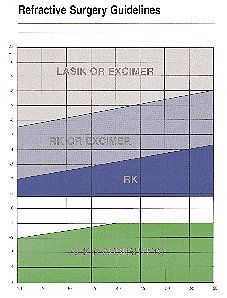Refractive surgery patients need direction
 --- Mark Danzo.
--- Mark Danzo.
As refractive surgery continues to evolve with advancements in technology, a new problem has emerged. When radial keratotomy was the only effective means of reducing nearsightedness and astigmatism for a prospective refractive surgery patient, the choice was easier: to do or not to do surgery. Recently, new issues have arisen.
The excimer laser was approved last month by the U.S. Food and Drug Administration, and access to the excimer laser is increasing abroad. Recently, automated lamellar keratoplasty (ALK) and laser-assisted in situ keratomileusis (LASIK) have been introduced, and they appear to have promising results. An issue that was once simple has escalated into a complex decision-making process for the prospective patient. Today’s refractive surgery candidates need direction.
Simplify patient information
With so many surgical choices, the abundance of information can be overwhelming, and today’s prospective patients can be easily scared away from refractive surgery entirely. It is important to simplify decision making for a patient.
Remember, refractive surgery is not a universally accepted procedure for ametropic vision correction. Many prospective patients still believe that these procedures are “experimental.” An overwhelming decision-making process can make them run back to the more proven forms of correction.
 --- Sample RSG graph.
--- Sample RSG graph.
There is one way for your practice to separate itself from its competitors. Your role as an educator and a primary care optometrist requires you to give the public concise, confident direction. Using the refractive surgery guideline (RSG) graph can give you the ability to do just that.
Incorporating this graph into patient education allows your practice to achieve several goals. First and foremost, it softens the question of whether refractive surgery is a wise choice.
Let’s compare the refractive surgery inquiry of a potential patient with the purchase of an automobile. When an interested consumer enters a showroom, the salesman does not ask if he or she would like to purchase a new car. The salesman asks which model best suits the consumer’s needs. The RSG graph uses that same philosophy. The question now is “which of these refractive surgery procedures best meet your needs?” and not “Is refractive surgery a wise choice?” The public likes to have a choice, so give it that choice within the constraints of your educated recommendations.
Staff can use RSG graph
The next advantage of using the RSG graph is that it serves as an educational tool for your staff. Many times, I am exposed to practices that allow uneducated staff members to field questions from prospective refractive surgery patients. This creates disastrous results. The impression that uneducated staff members leave on a potential patient can ruin your patient volume.
Many practices use a refractive surgery coordinator; however, this employee cannot be everywhere and is often on the telephone or with a patient in a consultation. Making others wait to acquire information is bad customer service. Cross-training front desk staff is helpful, but it is unrealistic to expect your front desk personnel to have all the answers.
The graph will allow the receptionist to quickly make these recommendations in writing. This also provides the staff member with the ability to dispense the appropriate materials upon request. Before long, the whole staff will become comfortable using the graph. Making quick, confident recommendations makes your staff look and feel competent.
It is important for your staff to stress that these are just recommended guidelines and that final recommendations cannot be made until the patient has had an examination. One thing that makes this graph such a universal tool is its ability to be customized.
Sample graph first
Create a template for your refractive surgery patients that reflects your specific beliefs. Setting guidelines you are comfortable with is paramount. Try a sample graph internally for a few weeks to work out the bugs. After you are sure it accurately reflects your recommendations, print up a colorful version to distribute to patients. Considering the low production costs of this piece of collateral material, updates and revisions are fairly easy and inexpensive.
The RSG graph can provide your potential patients with highly sought-after direction. Something motivated them to inquire about these procedures, and you should not risk losing them.
These patients want to change something in their visual lives. Presenting confusing choices can defuse their enthusiasm and energy or stop them from following through with their initial desires. Focusing their energy in a definite direction can keep prospective patients on course and excited about refractive surgery.
